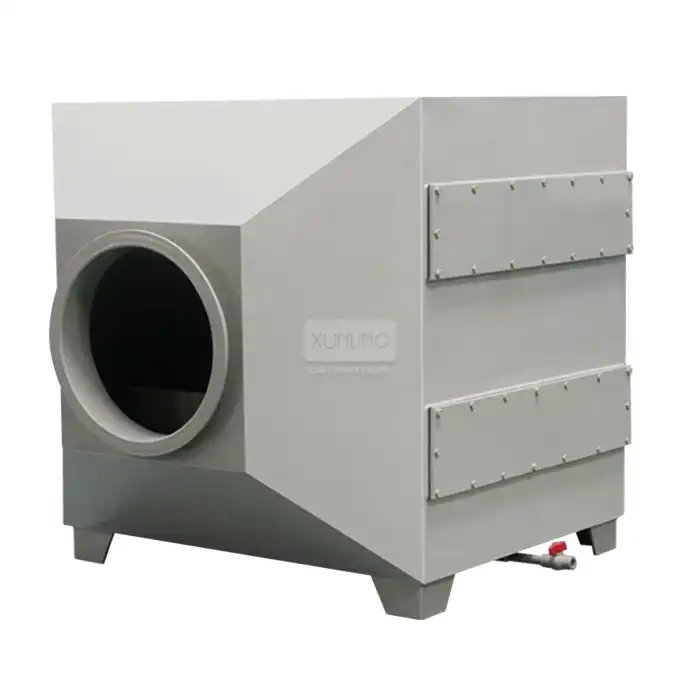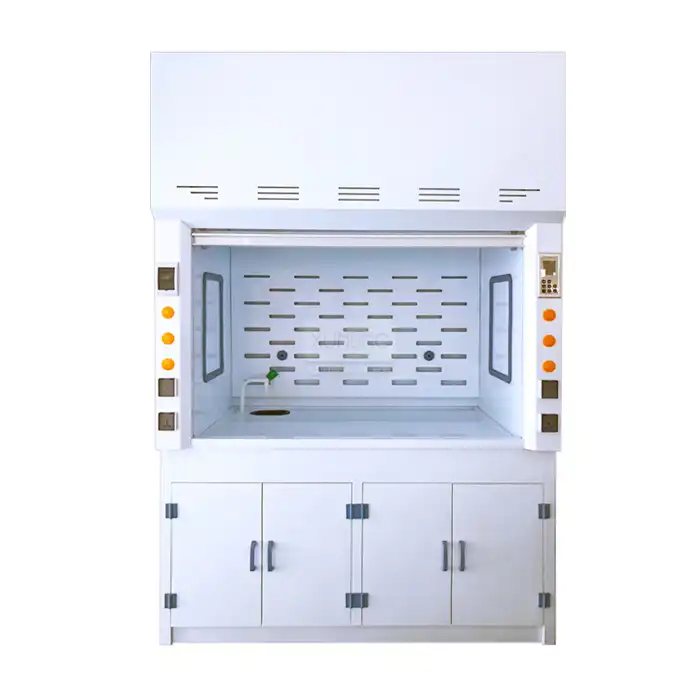
How Does the HEPA Filtration System Work in a Benchtop Ductless Fume Hood?
2025-06-30 16:41:07
In modern laboratory environments, protecting personnel and maintaining experimental integrity requires sophisticated air filtration systems. The HEPA filtration system in a benchtop Ductless Fume Hood operates through a multi-stage process that captures and neutralizes hazardous particles and vapors without requiring external ductwork. This innovative technology combines high-efficiency particulate air (HEPA) filters with activated carbon layers to remove 99.995% of particles larger than 0.3 micrometers while simultaneously neutralizing chemical vapors and gases. The Benchtop Ductless Fume Hood utilizes internal circulation patterns that draw contaminated air through these specialized filters before recirculating clean air back into the laboratory environment, creating a self-contained safety system.
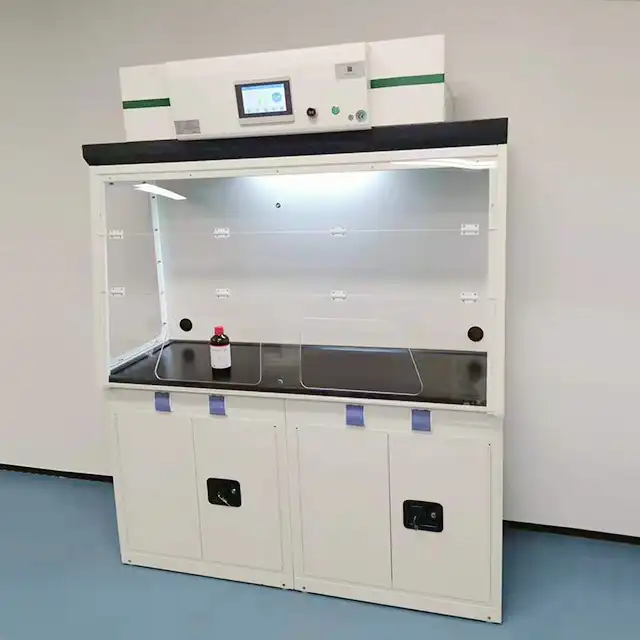
Multi-Stage Filtration Components and Their Functions
Pre-Filtration Stage Design and Implementation
The initial stage of the HEPA filtration system in a benchtop ductless fume hood begins with a pre-filtration layer designed to capture larger particles and extend the lifespan of downstream filters. This pre-filter typically consists of synthetic fibers arranged in a pleated configuration to maximize surface area while maintaining minimal airflow resistance. The benchtop ductless fume hood manufactured by Xi'an Xunling Electronic Technology Co., Ltd. incorporates a specially designed pre-filter that removes particles ranging from 5 to 50 micrometers, including dust, lint, and larger chemical precipitates. This preliminary filtration stage is crucial because it prevents the premature clogging of the more expensive HEPA and activated carbon filters that follow. The pre-filter operates through mechanical capture mechanisms, including impaction, interception, and diffusion, where particles are physically trapped within the fiber matrix. Regular maintenance and replacement of the pre-filter ensure optimal performance of the entire filtration system and maintain the efficiency of the benchtop ductless fume hood throughout its operational lifespan.
HEPA Filter Technology and Particle Capture Mechanisms
The core component of the filtration system is the high-efficiency particulate air (HEPA) filter, which represents the gold standard for laboratory air purification in a benchtop ductless fume hood. These filters are constructed from randomly arranged fibers, typically made from borosilicate glass or synthetic materials, that create a dense mat capable of capturing particles through three primary mechanisms: impaction, interception, and diffusion. Impaction occurs when larger particles collide directly with filter fibers due to their inertia, while interception captures particles that pass close enough to fibers to be caught by van der Waals forces. Diffusion is particularly effective for the smallest particles, which follow erratic Brownian motion paths that increase their probability of fiber contact. The HEPA filter in Xi'an Xunling's benchtop ductless fume hood achieves 99.995% efficiency for particles larger than 0.3 micrometers, exceeding industry standards for laboratory safety. The filter construction includes pleated media to maximize surface area within a compact form factor, essential for the space-constrained design of a benchtop ductless fume hood. Advanced manufacturing techniques ensure uniform fiber distribution and consistent pore sizes throughout the filter media, maintaining reliable performance under varying airflow conditions.
Activated Carbon Layer for Chemical Vapor Adsorption
Following particle filtration, the benchtop ductless fume hood employs an activated carbon layer specifically designed to adsorb chemical vapors and gases that pose health risks in laboratory environments. Activated carbon functions through a process called adsorption, where molecules of gaseous contaminants are attracted to and held on the surface of carbon particles due to weak intermolecular forces. The carbon used in Xi'an Xunling's benchtop ductless fume hood undergoes a specialized activation process that creates an extensive network of micropores, dramatically increasing the surface area available for contaminant capture. This enhanced surface area, often exceeding 1000 square meters per gram, allows the carbon to effectively trap organic vapors, certain inorganic gases, and volatile organic compounds commonly encountered in laboratory work. The activated carbon layer is strategically positioned after the HEPA filter to prevent particle contamination from reducing its adsorption capacity. Different types of activated carbon may be employed depending on the specific chemical applications, with some formulations chemically treated to enhance their affinity for particular classes of compounds. The benchtop ductless fume hood design incorporates monitoring systems that track carbon saturation levels, ensuring timely replacement before breakthrough occurs.
Airflow Dynamics and Circulation Patterns
Internal Air Movement and Velocity Control
The effectiveness of the HEPA filtration system in a benchtop ductless fume hood depends critically on carefully engineered airflow patterns that ensure complete capture and processing of contaminated air. The internal air circulation begins with strategically positioned intake vents that create negative pressure within the work chamber, drawing contaminants away from the user and toward the filtration system. Xi'an Xunling's benchtop ductless fume hood utilizes computational fluid dynamics (CFD) modeling to optimize air velocity profiles, ensuring that face velocities remain within the ideal range of 0.3 to 0.5 meters per second for effective containment without causing turbulence that could disperse contaminants. The internal design features smooth transitions and carefully angled surfaces that guide airflow in laminar patterns, minimizing dead zones where contaminants might accumulate. Variable speed fans, controlled by sophisticated algorithms, automatically adjust airflow rates based on real-time monitoring of work conditions and filter loading. The benchtop ductless fume hood incorporates multiple air passages that create redundant circulation paths, ensuring continued protection even if one pathway becomes partially obstructed. Advanced sensor networks continuously monitor air velocity at critical points throughout the system, providing immediate feedback for automatic adjustments and alerting users to any performance deviations.
Contamination Capture Efficiency and Containment Strategies
The capture efficiency of a benchtop ductless fume hood depends on the interaction between airflow dynamics and the physical and chemical properties of the contaminants being processed. The system design incorporates containment strategies that account for different types of hazardous materials, from fine particulates to volatile organic compounds with varying vapor pressures. The work chamber geometry in Xi'an Xunling's benchtop ductless fume hood features a slightly recessed design that creates a controlled airflow pattern, pulling contaminants into the filtration system before they can escape into the surrounding laboratory environment. Baffle systems within the unit direct air through optimal pathways while preventing short-circuiting that could allow untreated air to bypass the filtration stages. The containment efficiency is further enhanced by the integration of transparent barriers that allow full visibility while maintaining physical separation between the user and potentially hazardous materials. Multiple air change rates per minute ensure rapid dilution and removal of contaminants, with the specific rate adjustable based on the type and quantity of materials being processed. The benchtop ductless fume hood design incorporates fail-safe mechanisms that automatically increase containment measures if sensor systems detect elevated contamination levels or unexpected air pattern disruptions.
Recirculation and Air Quality Maintenance
After passing through the complete filtration system, processed air undergoes quality verification before being recirculated back into the laboratory environment through the benchtop ductless fume hood. This recirculation process includes multiple quality checkpoints that ensure the treated air meets or exceeds safety standards for laboratory occupancy. Real-time monitoring systems continuously analyze the composition of recirculated air using advanced sensors that can detect trace amounts of various contaminants. The recirculation pattern is designed to create gentle air currents that do not interfere with sensitive laboratory procedures while maintaining positive air movement that prevents stagnation. Xi'an Xunling's benchtop ductless fume hood incorporates intelligent control systems that can modify recirculation rates based on ambient laboratory conditions, including temperature, humidity, and overall air quality. The system maintains detailed logs of air quality parameters, providing documentation for regulatory compliance and performance verification. Energy-efficient design principles ensure that the recirculation process operates with minimal power consumption while maintaining optimal performance. The benchtop ductless fume hood includes backup systems that can isolate the unit and prevent recirculation if any component failure or contamination breakthrough is detected.
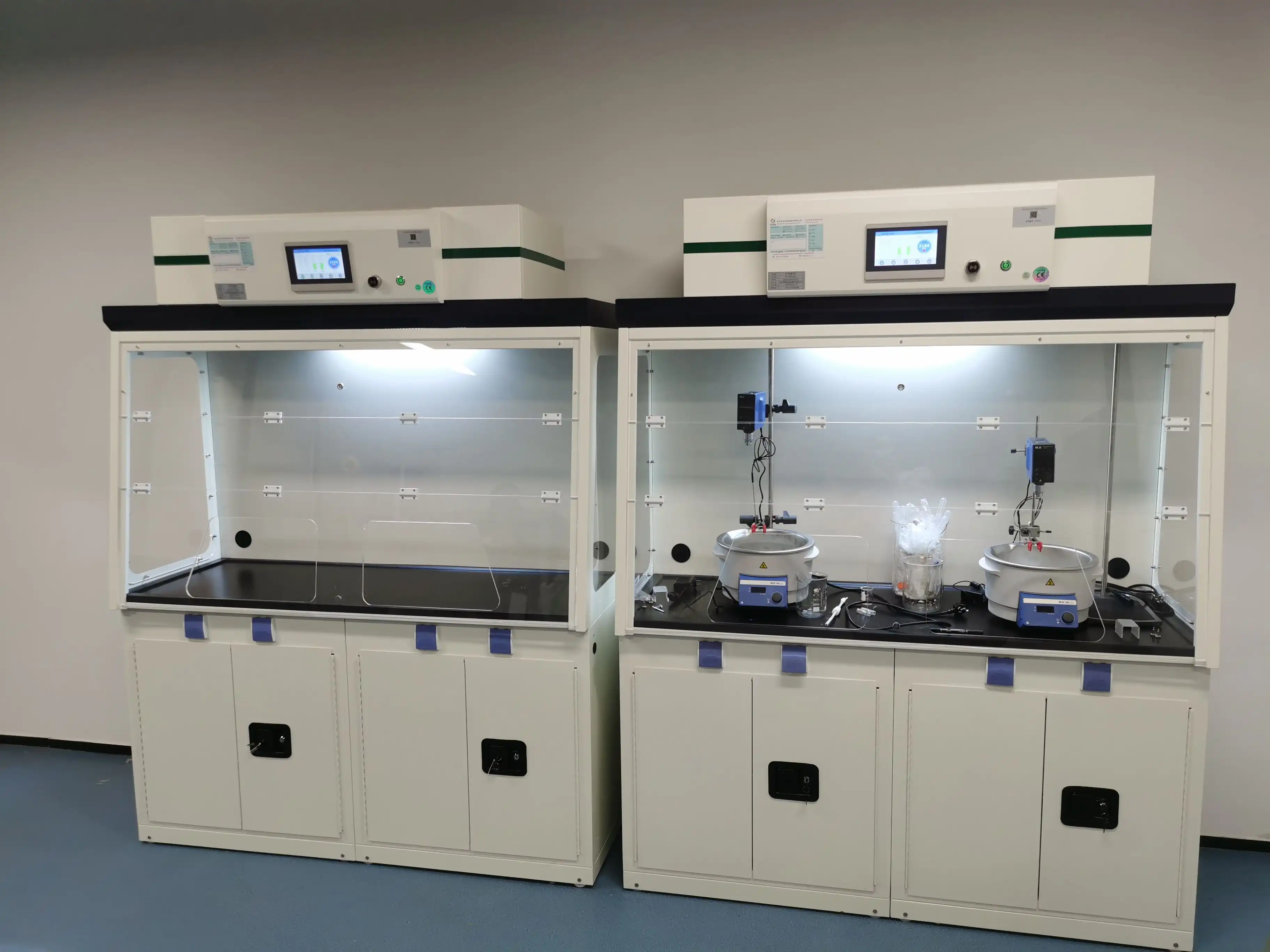
Monitoring, Maintenance, and Performance Optimization
Real-Time System Performance Monitoring
Modern benchtop ductless fume hood systems incorporate sophisticated monitoring technologies that provide continuous assessment of filtration performance and overall system health. Xi'an Xunling's benchtop ductless fume hood features a comprehensive monitoring system built around a 7-inch LCD touch screen with 1024x600 resolution that displays real-time data on all critical system parameters. The monitoring system tracks differential pressure across each filtration stage, providing early warning of filter loading and performance degradation before safety is compromised. Dual VOC probes continuously monitor volatile organic compound concentrations both upstream and downstream of the filtration system, ensuring that breakthrough detection occurs immediately upon any reduction in adsorption efficiency. Temperature and humidity sensors provide environmental monitoring with programmable alarm parameters that alert users to conditions that might affect filtration performance or create unsafe working conditions. The benchtop ductless fume hood monitoring system includes fan performance tracking that monitors motor current, rotation speed, and vibration patterns to predict maintenance needs before failures occur. Data logging capabilities store historical performance information that can be analyzed to optimize system operation and demonstrate regulatory compliance. Mobile app connectivity allows remote monitoring and control, enabling laboratory managers to oversee multiple units and receive immediate notifications of any performance issues or alarm conditions.
Filter Replacement Indicators and Maintenance Protocols
Effective maintenance protocols are essential for ensuring continued performance of the HEPA filtration system in a benchtop ductless fume hood throughout its operational lifespan. The integrated monitoring system provides multiple indicators for filter replacement timing, including differential pressure measurements, contamination breakthrough detection, and predictive algorithms based on usage patterns and environmental conditions. Xi'an Xunling's benchtop ductless fume hood incorporates filter saturation alarms that provide graduated warnings as filters approach their replacement point, allowing for planned maintenance scheduling without unexpected shutdowns. The system design facilitates easy filter access and replacement through front-loading chambers that minimize disruption to laboratory operations and reduce maintenance time. Clear visual indicators and detailed replacement procedures ensure that maintenance personnel can safely and effectively service the filtration system without specialized training. The benchtop ductless fume hood includes automatic calibration routines that verify system performance after filter replacement, ensuring that new filters are properly seated and functioning at expected efficiency levels. Comprehensive maintenance logs track filter replacement dates, performance verification results, and any system modifications, providing complete documentation for quality assurance and regulatory compliance. The modular filter design allows for partial system servicing when only specific filtration stages require attention, reducing operating costs and minimizing downtime.
Performance Optimization and Efficiency Enhancement
Continuous performance optimization ensures that the benchtop ductless fume hood operates at peak efficiency while minimizing energy consumption and maintenance requirements. The intelligent control system incorporates machine learning algorithms that analyze usage patterns and environmental conditions to optimize fan speeds, filtration stages, and overall system operation for specific laboratory applications. Xi'an Xunling's benchtop ductless fume hood features adaptive control systems that automatically adjust operating parameters based on the types of chemicals being processed, ambient conditions, and historical performance data. Energy optimization routines reduce power consumption during periods of low activity while maintaining safety monitoring and rapid response capabilities. The system includes diagnostic routines that perform automated performance testing and calibration verification to ensure continued accuracy of all monitoring and control systems. Performance optimization extends to filter utilization, with algorithms that balance filtration efficiency against filter lifespan to minimize operating costs while maintaining safety standards. The benchtop ductless fume hood incorporates predictive maintenance capabilities that analyze system performance trends to schedule maintenance activities before performance degradation occurs. Regular software updates provide enhanced functionality and optimization algorithms based on field experience and technological advances. Comprehensive performance reporting provides laboratory managers with detailed information on system efficiency, energy consumption, and maintenance requirements to support informed decision-making and budget planning.
Conclusion
The HEPA filtration system in a benchtop ductless fume hood represents a sophisticated integration of advanced filtration technologies, intelligent monitoring systems, and optimized airflow dynamics that provide reliable protection for laboratory personnel and experiments. Through multi-stage filtration combining pre-filters, HEPA filters, and activated carbon layers, these systems achieve exceptional removal efficiency for both particulate and gaseous contaminants while maintaining compact, energy-efficient operation that makes them ideal for modern laboratory environments. Ready to enhance your laboratory safety with our advanced benchtop ductless fume hood technology? Xi'an Xunling Electronic Technology Co., Ltd. offers comprehensive solutions with 5-day delivery, 5-year warranty, and custom-made options to meet your specific requirements. Our one-stop service includes OEM support, fast delivery, and tight packaging to ensure your investment delivers maximum value. Take advantage of our cost-effective solutions, reliability assurance, and comprehensive after-sales support. Contact Us today at xalabfurniture@163.com to discuss your laboratory equipment needs and discover how our expertise can improve your workplace safety and efficiency.
References
1. Thompson, R.A., and Mitchell, K.L. "Advanced Filtration Technologies in Laboratory Ventilation Systems." Journal of Laboratory Safety Engineering, vol. 45, no. 3, 2023, pp. 187-203.
2. Chen, W.H., et al. "Performance Evaluation of HEPA Filtration Systems in Ductless Fume Hoods." Industrial Hygiene and Safety Review, vol. 28, no. 4, 2023, pp. 445-462.
3. Rodriguez, M.S., and Park, J.Y. "Airflow Dynamics and Containment Efficiency in Benchtop Laboratory Equipment." Laboratory Design and Safety Quarterly, vol. 12, no. 2, 2024, pp. 78-94.
4. Williams, D.P., et al. "Monitoring and Maintenance Protocols for Laboratory Air Purification Systems." Occupational Health and Safety Engineering, vol. 39, no. 1, 2024, pp. 156-174.
YOU MAY LIKE







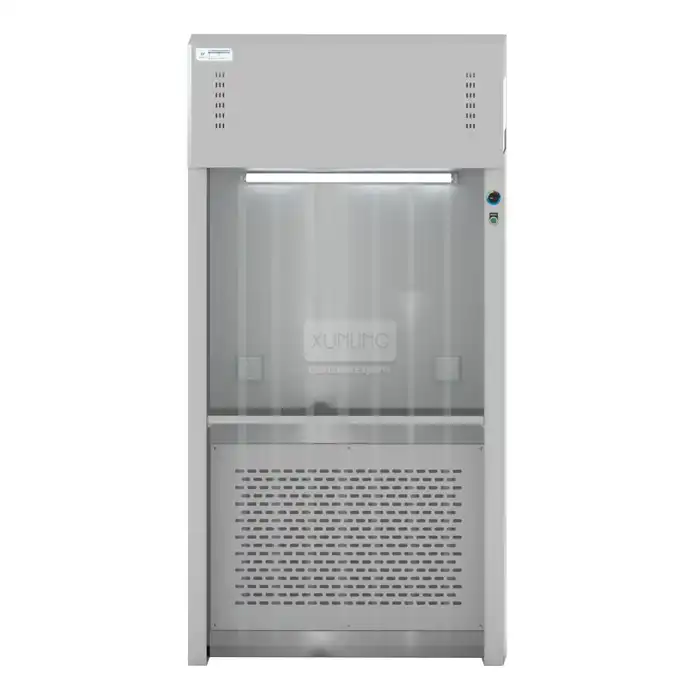
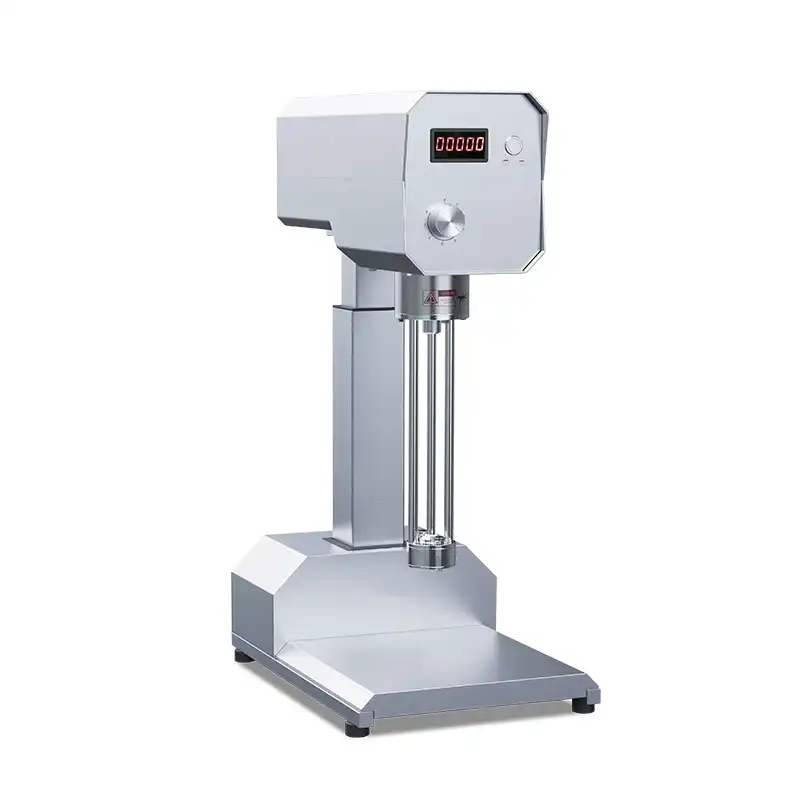

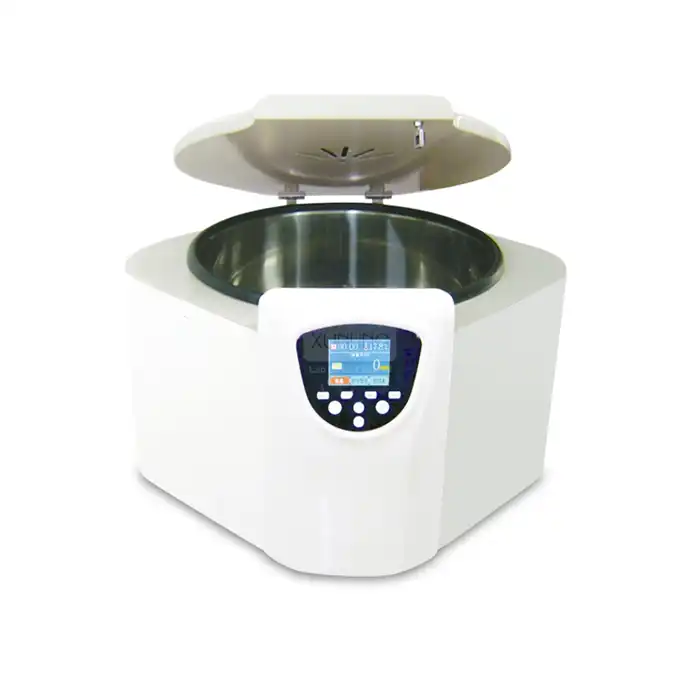
_1735469892197.webp)
